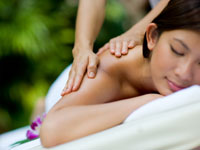Spotted on the galactic interweb! I wanted to share this - it's sage advice.
~Stephanie
Massage isn’t just a me-time indulgence. Studies show it reduces stress, boosts immunity, and relieves pain from everyday wear and tear. And in tough times, just 30 minutes on the table (or even 10 minutes in a chair) can go a long way toward working out your kinks—as long as you make sure your needs are met. Here’s how to get your money’s worth.~Stephanie
 Find the right therapist
Find the right therapist Just as you would with an MD, select a certified massage therapist who meets your specific needs, whether you’re looking to soothe postmarathon aches or relieve a stiff neck. General certification in Swedish massage—long, sweeping strokes over the entire body—fits the bill when you’re simply looking to relax. (Swedish is what you’ll get if you ask for a basic massage; Shiatsu, or acupressure, features more targeted finger pressure in specific areas.) Go here to find the most experienced certified massage therapists in your area.
Speak up!
Before the massage begins, mention any areas of your body that are feeling sensitive, tight, painful, or tender (like a knot in your neck or an achy spot in your shoulder); these should be treated with particular care, according to Leena Guptha, an osteopathic doctor, a licensed massage therapist, and past president of the American Massage Therapy Association.
Most massage isn’t painful, though moderate pressure—which studies have found is necessary to provide optimal therapeutic benefits—may feel a little uncomfortable, especially if you’re new to massage. Is the pressure too intense? Don’t be shy. Guptha suggests saying something like, “That really hurts. Can you try something different or skip this area?” A good therapist should welcome (or even ask for) your input.
Pick your products
It’s acceptable to bring your own lotion or oil, especially if you have sensitive skin, a sensitive nose, or a condition like eczema or psoriasis. Another option: Ask the therapist to show you her product stash and discuss the options (many are fragrance-free). “There are dozens available for different types of massage, and your therapist should have a variety to choose from,” Guptha says.
Reschedule if you have a cold
“Postpone your massage if you feel a cold or migraine coming on,” Guptha says. “The massage will stimulate your circulation, which could leave you feeling worse.” If you’re a little stuffy or just find it difficult to breathe when lying face-down, ask to lie on your side. An experienced therapist can perform most techniques this way, or she can work on your upper back, neck, and shoulders while you’re in a sitting position.
Period? No problem
There’s no medical reason to avoid a massage during your period, Guptha says. In fact, it can ease PMS symptoms like cramps and backache. But if you’re worried about heavy bleeding, just wait a few days.